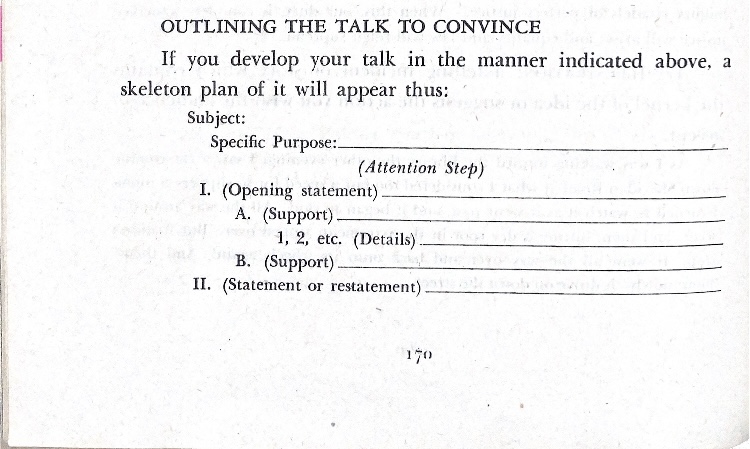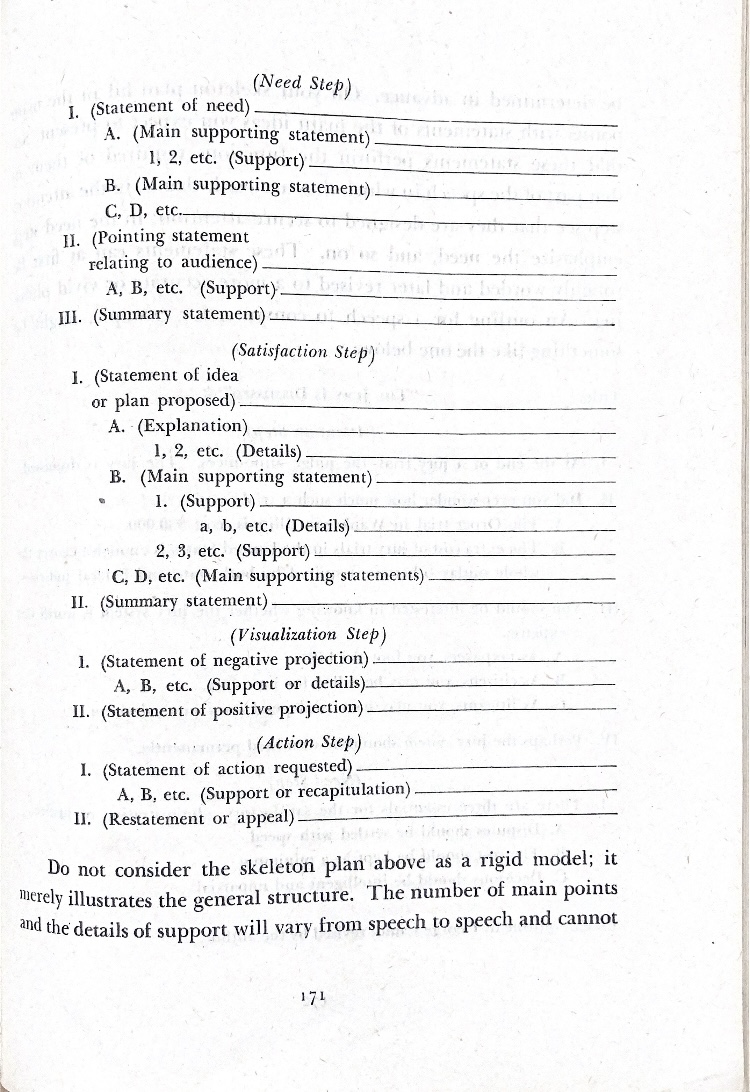Monroe’s Motivated Sequence: How to Use it in RCM 401
Maeve Balmer
In RCM 401, there are many instances where you will have to make a speech. Additionally, in future classes, and in our future careers, speeches and presentations are inevitable. Maybe in the past we have experienced or given a speech or presentation quite similar to this one:
This speech may have looked a little too familiar. In this class, we are aiming to work on many different aspects of formatting and presenting speeches. One way to help your speech come together is to use a structure, or sequence, that has been developed, and proven, to be an effective tool in speech presentation.
One such tool is Monroe’s Motivated Sequence. This speech strategy was developed in the 1930s by a professor in public speaking, Alan Monroe (Lucas, 2012). He developed this sequence as a way to use the psychology of persuasion to convince an audience of an action. Monroe’s sequence is comprised of five steps: Attention, Need, Satisfaction, Visualization, and Action. When the sequence is followed in order of these steps, it follows the process of human thinking (Lucas, 2012).
This sequence is a useful tool to adapt to the speeches made in an RCM class. The structure that the sequence provides is clear for the audience to follow along with and is a valuable tool when planning the outline for a speech. The motivated sequence is used to persuade, and thus can be a useful strategy when thinking about how to structure your own speech, as you convince your audience of an action.
Now that we know why Monroe’s Motivated Sequence may be a helpful addition to an RCM 401 speech, we will be able to put it into action. Below are the steps followed throughout the sequence.
The Five Steps
-
Attention
Gaining the attention of the audience.
Monroe states that you have to change, or influence, the attitudes of the audience at the very beginning in order to convince them of an action (Monroe, 1945). By getting their attention, you direct their focus to what you are presenting. In RCM 401, this is the hook of your argument.
Some examples that can be used in the attention step are (Monroe, 1945, p.119):
- Reference to the subject or problem
- Rhetorical question
- Startling statement
- Anecdote
- Illustration
These are all simple ways to gain interest about your topic. This could be a fact about the industry you are speaking on, something that has been in the news lately, or some misconceptions of your topic. Additionally, it will ensure that your topic is already in the minds of your audience before you begin with the content of your speech.
-
Need
Make the audience feel a need for change; describe the problem.
To make the audience want to act, they have to be aware of a problem. Monroe (1945) describes the need portion of the speech as showing the audience what is wrong, right now. This is the exigence of your speech.
Monroe (1945) proposes a four-step development of the need (p. 164), including a statement of need, illustration of need, or evidence, ramifications, or convincing of the need, and finally a pointing of the need. However, two of these steps are essential in every speech: statement of need and pointing of the need.
A statement of the need is a concise statement of the exact nature of the problem (Monroe, 1945, p.162). This statement ensures the entire audience has the same understanding of the problem, and what stance your speech has taken.
One of the most important steps we can utilize as students in 401 is the pointing step. This is showing the relation of the problem to the audience. This ensures that the exigence you are proposing is an issue that the audience can relate to and care about, which gives them involvement in your speech. Making sure that the audience feels connected to the topic helps to develop pathos appeal, while also demonstrating your own goodwill, or ethos.
When presenting the need in a 401 speech, it can be helpful to take the time to develop this exigence. By providing some research on the problem now, you are getting the audience invested in the speech early.
-
Satisfaction
Provide a solution to the problem.
In this step, you are providing a resolution to the need. You have shown the audience what the problem is, and are now telling them how to fix it. Monroe (1945) proposes a 5-step development in the satisfaction step, however, three are especially useful to outline in an RCM 401 class:
I. State the action
In RCM 401, this is the action that you are persuading the audience to take.
II. Explanation
State the explanation of the action clearly; provide any specifics or timeframes to the action to make sure it is understood by the audience.
III. Demonstration
In this step, you are demonstrating how your proposed action is a solution to the problem. In RCM 401, it may be helpful to think of this step as the body of the speech, and develop your speech surrounding the topics you present in this demonstration step.
The other steps Monroe proposed are IV. Examples of practical experience, and V. Objections. However, the provision of examples and the addressing of possible objections, or constraints, may be more useful if they are addressed along with the other steps of the satisfaction.
During this step, ethos, pathos, and logos can be developed. Ethos is shown in the development of your argument, and its connection to the audience, especially by addressing constraints. Pathos and logos likely appear in your demonstration step, through research of the topics and the examples given.
-
Visualization
Intensify desire for the action to be carried out.
During this step, you are bringing the audience into the future and showing them the result of the action or inaction taken. Monroe (1945) suggests doing this in one of three ways:
I. Positive Projections
Describe the conditions of the future if the action is put into place.
II. Negative Projections
Describe the consequences in the future if the proposed action is not taken; draw ideas from the need step of the sequence. What need would go unfulfilled, and what would life look like?
III. Contrast
First, use a negative projection and then contrast it with a positive projection.
The most important part of visualization is that it is probable, the scenario is something that relates to your audience and is likely to arise in their future (Monroe, 1945, p. 166).
This step is a helpful addition to an RCM 401 speech as it helps to reinforce the action in a way that connects with your audience, by putting them into the situation. This can help develop your pathos appeal, as well as create common ground with your audience, as you and your audience are put into a situation together.
-
Action
Conclude with a reinforcement of the action.
One way that Monroe suggests using the action step, which is useful for a 401 speech, is by doing a summary. By summarizing the need and satisfaction portions of your speech, and ending with a last strong call to action, the audience follows along easily with the points made, and the action is reinforced one last time.
Another idea for how to reinforce the action is by stating your personal intention to take the course of action you have recommended. This is effective if the action can be done immediately; tell the audience that you will do it tonight and maybe they will too.
Monroe’s (1945) final piece of advice is to keep this step short and to the point (p. 170).
Outline of Monroe’s Motivated Sequence (Monroe, 1945, pp.170-171)


Preparing for a speech can be difficult. Maybe you are in a rush as the speech fell right during midterms, or you are busy with assignments, and you may begin to feel overwhelmed with where to start with your argument and structure. Maybe you have a great idea but are struggling with how to get your thoughts organized to present your speech, and you are worried your speech might end up like the one at the beginning of this chapter. However, by using Monroe’s Motivated Sequence, you now have an outline to follow, with five steps to work on developing. Additionally, you will be considering how your audience will respond to each part of your speech, and you can develop the need and satisfaction steps to urge your audience to act. With this organization, you will be able to confidently stand in front of your class and present a well-rounded, organized speech.
Monroe’s Motivated Sequence is an effective tool for planning a persuasive speech by explaining a problem and presenting a solution (Lucas, 2012). A detailed discussion and clear organization are effective ways to develop ideas for a presentation, and present a great speech to your class.
References
Lucas, S. (2012). The Art of Public Speaking. McGrawHill Learning Solutions.
Monroe, A. H. (1945). Monroe’s principles of speech: Brief edition. Scott, Foresman.

